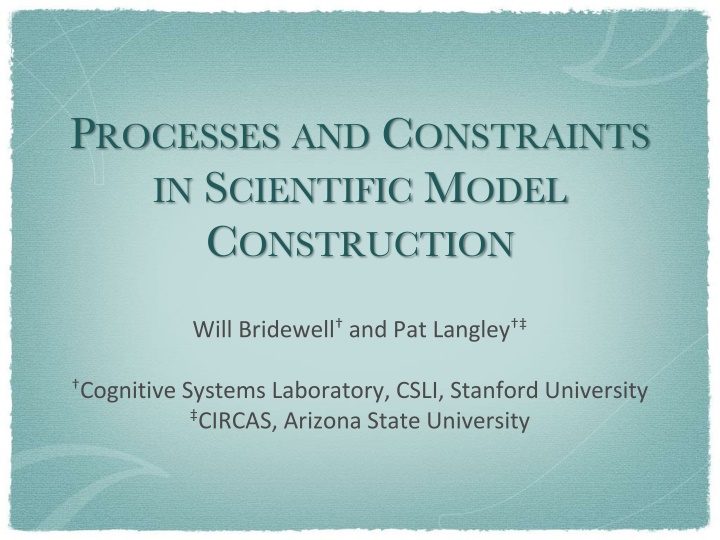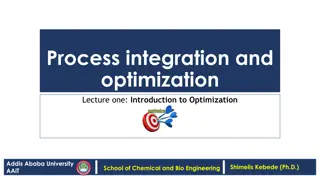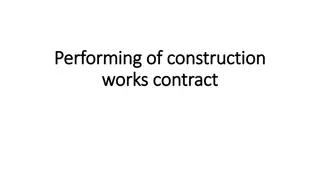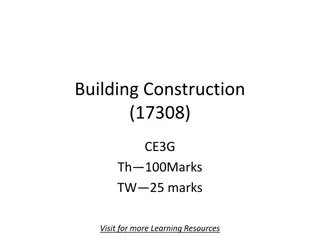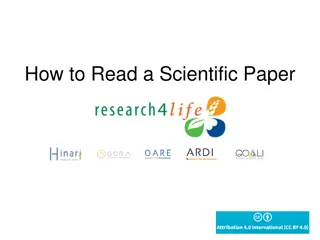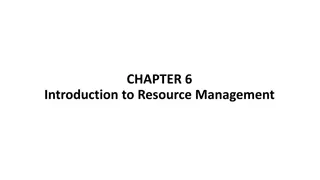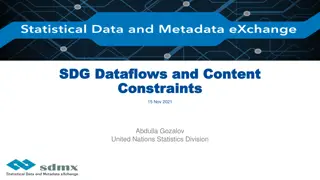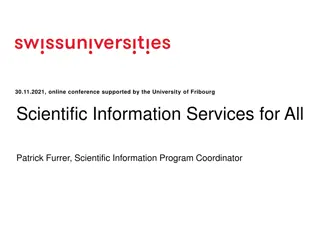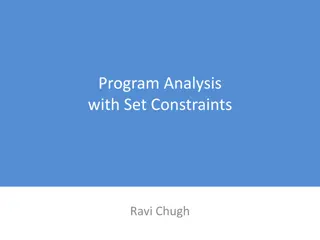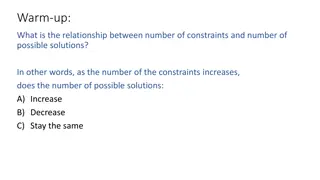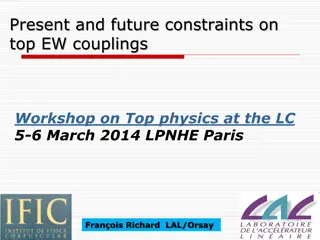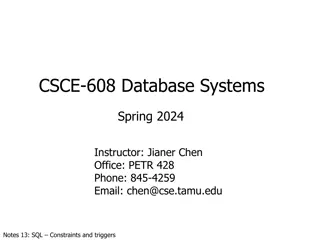Processes and Constraints in Scientific Model Construction
Constructing scientific models involves understanding processes and constraints. Inductive process modeling, quantitative process models, and modularity play crucial roles in this construction. Advantages of quantitative process models include embedding quantitative relations in qualitative structures, providing dynamic predictions, offering causal explanations, and maintaining modularity. These models serve as a promising framework for computational discovery, providing scientists with valuable insights into various phenomena.
Download Presentation

Please find below an Image/Link to download the presentation.
The content on the website is provided AS IS for your information and personal use only. It may not be sold, licensed, or shared on other websites without obtaining consent from the author.If you encounter any issues during the download, it is possible that the publisher has removed the file from their server.
You are allowed to download the files provided on this website for personal or commercial use, subject to the condition that they are used lawfully. All files are the property of their respective owners.
The content on the website is provided AS IS for your information and personal use only. It may not be sold, licensed, or shared on other websites without obtaining consent from the author.
E N D
Presentation Transcript
PROCESSES AND CONSTRAINTS IN SCIENTIFIC MODEL CONSTRUCTION Will Bridewell and Pat Langley Cognitive Systems Laboratory, CSLI, Stanford University CIRCAS, Arizona State University
Where Are We Going? Introduction to inductive process modeling Constraints in inductive process modeling Learning constraints
Inductive Process Modeling Model Observations Predictions Model Objectives: Explanation and Prediction Langley et al. 2002, ICML; Bridewell et al. 2008, ML
Quantitative Process Models Ordinary Differential Equations dhare.density/dt = 2.5 * hare.density + 0.1 * hare.density * wolf.density dwolf.density/dt = 1.2 * wolf.density + 0.3 * 0.1 * hare.density * wolf.density Processes process exponential_growth equationsd[hare.density, t, 1] = 2.5 * hare.density process exponential_loss equationsd[wolf.density, t, 1] = 1.2 * wolf.density process predation_holling_type_1 equationsd[hare.density, t, 1] = 0.1 * hare.density * wolf.density d[wolf.density, t, 1] = 0.3 * 0.1 * hare.density * wolf.density
Advantages of Quantitative Process Models Process models offer scientists a promising framework because: they embed quantitative relations within qualitative structure; that refer to notations and mechanisms familiar to experts; they provide dynamical predictions of changes over time; they offer causal and explanatory accounts of phenomena; while retaining the modularity needed for induction/abduction. Quantitative process models provide an important alternative to formalisms used currently in computational discovery.
Modularity in Quantitative Process Models Ordinary Differential Equations dhare.density/dt = 2.5 * hare.density + 0.1 * hare.density * wolf.density dwolf.density/dt = 1.2 * wolf.density + 0.3 * 0.1 * hare.density * wolf.density Processes process exponential_growth equationsd[hare.density, t, 1] = 2.5 * hare.density process exponential_loss equationsd[wolf.density, t, 1] = 1.2 * wolf.density process predation_holling_type_1 equationsd[hare.density, t, 1] = 0.1 * hare.density * wolf.density d[wolf.density, t, 1] = 0.3 * 0.1 * hare.density * wolf.density
Modularity in Quantitative Process Models Ordinary Differential Equations dhare.density/dt = 2.5 * hare.density dwolf.density/dt = 1.2 * wolf.density Processes process exponential_growth equationsd[hare.density, t, 1] = 2.5 * hare.density process exponential_loss equationsd[wolf.density, t, 1] = 1.2 * wolf.density
Modularity in Quantitative Process Models Ordinary Differential Equations dhare.density/dt = 2.5 * hare.density + 0.1 * hare.density * wolf.density / (1 + 0.2 * 0.1 * hare.density) dwolf.density/dt = 1.2 * wolf.density + 0.3 * 0.1 * hare.density * wolf.density / (1 + 0.2 * 0.1 * hare.density) Processes process exponential_growth equationsd[hare.density, t, 1] = 2.5 * hare.density process exponential_loss equationsd[wolf.density, t, 1] = 1.2 * wolf.density process predation_holling_type_2 equationsd[hare.density, t, 1] = 0.1 * hare.density * wolf.density / (1 + 0.2 * 0.1 * hare.density) d[wolf.density, t, 1] = 0.3 * 0.1 * hare.density * wolf.density / (1 + 0.2 * 0.1 * hare.density)
Generic Processes generic process predation_Holling_1 entitiesP1{prey}, P2{predator} parametersr[0, infinity], e[0, infinity] equations d[P1.density, t, 1] = 1 * r * P1.density * P2.density d[P2.density, t, 1] = e * r * P1.density * P2.density
Generic Processes generic process predation_Holling_1 entitiesP1{prey}, P2{predator} parametersr[0, infinity], e[0, infinity] equations d[P1.density, t, 1] = 1 * r * P1.density * P2.density d[P2.density, t, 1] = e * r * P1.density * P2.density P1: hare P2: wolf Instantiation r: 0.1 e: 0.3
Generic Processes generic process predation_Holling_1 entitiesP1{prey}, P2{predator} parametersr[0, infinity], e[0, infinity] equations d[P1.density, t, 1] = 1 * r * P1.density * P2.density d[P2.density, t, 1] = e * r * P1.density * P2.density P1: hare P2: wolf Instantiation r: 0.1 e: 0.3 process wolves_eat_hares equations d[hare.density, t, 1] = 1 * 0.1 * hare.density * wolf.density d[wolf.density, t, 1] = 0.3 * 0.1 * hare.density * wolf.density
The IPM System (a naive approach) Given: - A library of generic entities and processes - Instantiated entities - Data Ground the generic processes with instantiated entities Generate all combinations of the ground processes Fit the numeric parameters of each structure Output: The best models based on fit to the data
Applications Aquatic Ecosystems Fjord Dynamics See Bridewell et al. 2008, Machine Learning, 71, 1 32 also, biochemical kinetics, protist interactions, photosynthesis
Life After IPM Early versions of inductive process modeling systems: help scientists formalize their modeling knowledge; let scientists consider several alternative models; reduce some of the drudgery of model construction; speed exploration and evaluation. However, IPM produces several structurally implausible models, some of which account quite well for the data.
Model Constraints Constraints on the structure of models: eliminate implausible models; reduce the size of the search space; make complex domains tractable; improve model accuracy during incomplete search. Structural constraints differ from constraints on model behavior most importantly because they do not require simulation. HIPM, Todorovski et al. AAAI-05
SC-IPM Constraints: Necessary Name: Nutrient-Replenishment Type: necessary Processes: nutrient_mixing(N), remineralization(N,_ ) Specifies Required Processes P = primary producer G = grazer N = nutrient
SC-IPM Constraints: Always-Together Name: Growth-Limitation Type: always-together Processes: limited(P), nutrient_limitation(P, N) All or None P = primary producer G = grazer N = nutrient
SC-IPM Constraints: Exactly-One Name: Growth-Alternatives Type: exactly-one Processes: exponential(P), logistic(P), limited(P) Mutual Exclusion P = primary producer G = grazer N = nutrient
SC-IPM Constraints: At-Most-One Name: Optional-Grazing Type: at-most-one Processes: holling_1(P,G), holling_2(P,G), holling_3(P,G) Enables Optional Processes P = primary producer G = grazer N = nutrient
The SC-IPM System 1. Ground the generic processes with instantiated entities. 2. Treat ground processes as Boolean literals. 3. Conjoin the individual constraints. 4. Rewrite the constraints in conjunctive normal form. 5. Apply a SAT solver (e.g., DPLL,WalkSAT). 6. Instant model structure! 7. Fit parameters, etc.
Advantages of SC-IPM SC-IPM adds several powerful features to IPM, such as: constraints that limit the consideration of implausible models; constraint modularity that eases control of the search space. The constraints used by SC-IPM typically come from a scientist s implicit knowledge, and we can both elicit them through examples and learn them computationally.
Learning Constraints Goal: Identify implicit or unknown constraints to use in future modeling tasks Plan: Analyze the space of model structures Use machine learning techniques to help Key Idea: Don t throw away any models Even the bad ones contain valuable information Bridewell & Todorovski 2007, ILP and KCAP
Learning Constraints Build and parameterize process models 1. Store the models for analysis 2. Formally describe the structure of the models 3. Identify good and bad models 4. Use ILP to generate descriptions of accurate and inaccurate model structures 5. Convert the descriptions into SC-IPM constraints 6. We chose Aleph by Ashwin Srinivasan due to its ready availability and capabilities.
Good and Bad Models Good Bad 1996 1997 Ross Sea
Extracted Constraints A model that includes a second-order exponential mortality process for phytoplankton will be inaccurate. (positive:560, negative: 0) A model that includes the Lotka Volterra grazing process will be inaccurate. (positive: 80, negative: 0) A model that lacks both the first and second order Monod growth limitation process between iron and phytoplankton will be inaccurate. (positive: 448, negative: 0)
Apply Constraints to Other Problems Ross Sea Across Years Search Spaces: 9x 16x smaller Model Distribution: more accurate
Apply Constraints to Other Domains Ross Sea to Bled Lake Bridewell & Todorovski AAAI-08 (Transfer Learning Workshop)
Related Work Other quantitative modelers LAGRAMGE (Todorovski & Dzeroski) PRET (Bradley & Stolle) Metalearning and others Learning Constraint Networks via Version Spaces (Bessiere et al.) Relational Clich s (Silverstein & Pazzani; Morin & Matwin) Mode Declarations in ILP (McCreath & Sharma) Rule Reliability from Prior Performance (Mark Reid)
Future Directions We are currently working in several directions which include: continuing the analysis of constraint transfer; closing the automated modeling + constraint learning loop; basing new analyses and methodologies on model ensembles; adapting the general strategies to other tasks; supporting other modeling paradigms. Inductive process modeling is a fruitful paradigm for exploring knowledge representation, modeling, discovery, and creativity in scientific practice.
